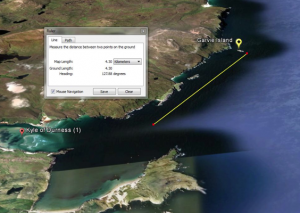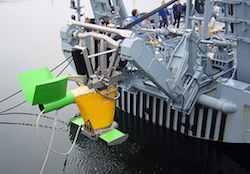Jun 30 2015
 A new Federal Aviation Administration (FAA) effort to modernize air traffic flow around major cities is ignoring the chance to do slight re-routing that would minimize air traffic over dwindling areas of natural quiet. The FAA is in the midst of a multi-year process to update the traffic patterns in and out of airports in 17 metropolitan areas. Each “metroplex” is served by multiple airports, and the FAA’s goal is to increase efficiency and on-time performance, using a number of strategies, including more precise coordination of flights into shared flight paths. This includes some effort to consolidate flight corridors, which has the good news/bad news effect of reducing air traffic noise over many areas, while increasing it in some of the new corridors. Unfortunately, some of the new concentrations of activity are over areas that were previously sanctuaries of natural quiet.
A new Federal Aviation Administration (FAA) effort to modernize air traffic flow around major cities is ignoring the chance to do slight re-routing that would minimize air traffic over dwindling areas of natural quiet. The FAA is in the midst of a multi-year process to update the traffic patterns in and out of airports in 17 metropolitan areas. Each “metroplex” is served by multiple airports, and the FAA’s goal is to increase efficiency and on-time performance, using a number of strategies, including more precise coordination of flights into shared flight paths. This includes some effort to consolidate flight corridors, which has the good news/bad news effect of reducing air traffic noise over many areas, while increasing it in some of the new corridors. Unfortunately, some of the new concentrations of activity are over areas that were previously sanctuaries of natural quiet.
The National Park Service’s Natural Sounds and Night Skies Program got involved early in this process, in the hopes that the new traffic schemes could reduce air traffic over relatively quiet park and wilderness lands. Over the past twenty years, the NPS has pioneered efforts to highlight and protect natural soundscapes; their monitoring and management techniques are gradually being adopted by public lands managers in other state and federal agencies. While deep wilderness settings are often the focus of these efforts (e.g. Grand Canyon, Yellowstone), many NPS holdings closer to urban areas provide easily accessible experiences of natural quiet.
A recent in-depth article in the East Bay Express looks at the way this has unfolded in the FAA’s planning of the Northern California Metroplex around the San Francisco bay area. The FAA has largely spurned the input from NPS, which hoped to protect or improve natural quiet opportunities in the Point Reyes National Seashore and in Yosemite National Park. Despite formal NPS requests, Read the rest of this entry »
Jun 29 2015
 In July 2011, 70 pilot whales were spotted in the shallow Kyle of Durness on the north coast of Scotland; as the tide went out, at least 39 were stranded. Quick efforts by locals and live-stranding groups managed to refloat 20 animals, but 19 perished. This month, a report commissioned by the UK’s governing agency, DEFRA, concluded that a series of bomb-disposal explosions were the most likely cause of the stranding. It’s a good reminder that much of the potential impact on wildlife from Navy exercises is from traditional ordinance, rather than sonar.
In July 2011, 70 pilot whales were spotted in the shallow Kyle of Durness on the north coast of Scotland; as the tide went out, at least 39 were stranded. Quick efforts by locals and live-stranding groups managed to refloat 20 animals, but 19 perished. This month, a report commissioned by the UK’s governing agency, DEFRA, concluded that a series of bomb-disposal explosions were the most likely cause of the stranding. It’s a good reminder that much of the potential impact on wildlife from Navy exercises is from traditional ordinance, rather than sonar.
While pilot whales are relatively common around Scotland, and there have been numerous strandings through the years, it’s unusual that they would venture into such a shallow, tidal bay. It seems likely that the pod was in the area relatively near shore (either following food, or transiting between feeding locations) when several bombs were exploded on the day before the stranding (yellow pointer on image). Navigational error (perhaps caused by hearing impairment) left them in the mouth of the bay (red pointer), 3-5 miles away, rather than offshore; the strandings had just begun when the final bomb was exploded the next day, which likely drove more animals into the shallows.
The report suggests that some whales may well have been close enough to suffer temporary or permanent hearing damage. In the most damning finding, it appears clear that monitoring for nearby animals was cursory at best, done only from small inflatable boats: Read the rest of this entry »
Jun 02 2015
 This week the Indian Navy confirmed its purchase of six low-frequency Active Towed Array Sonar (ACTAS) units, for use in tracking Chinese subs in the Indian Ocean. With a stated detection range of 60km (37mi), it appears that this system puts out far less sound than low frequency systems used by the US (SURTASS LFAS) or the British (Sonar 2087), both of which are effective to at least 100 nautical miles, and can be detected at much greater distances. It is remarkably hard to find information about the proliferation of these systems; the German-made ACTAS system is presumably being used elsewhere as well, while the UK Sonar 2087 is deployed on several UK Navy ships, and was recently also purchased by Chilean Navy. So far, the US Navy has plans to outfit 4 ships with its SURTASS LFA system, and it is used regularly in the western Pacific, monitoring Chinese and North Korean activity. While environmental groups continue to challenge US deployment of LFAS and to add biological safeguards to training programs using mid-frequency active sonar (see AEI coverage of both), these and similar systems continue to spread into waters around the world.
This week the Indian Navy confirmed its purchase of six low-frequency Active Towed Array Sonar (ACTAS) units, for use in tracking Chinese subs in the Indian Ocean. With a stated detection range of 60km (37mi), it appears that this system puts out far less sound than low frequency systems used by the US (SURTASS LFAS) or the British (Sonar 2087), both of which are effective to at least 100 nautical miles, and can be detected at much greater distances. It is remarkably hard to find information about the proliferation of these systems; the German-made ACTAS system is presumably being used elsewhere as well, while the UK Sonar 2087 is deployed on several UK Navy ships, and was recently also purchased by Chilean Navy. So far, the US Navy has plans to outfit 4 ships with its SURTASS LFA system, and it is used regularly in the western Pacific, monitoring Chinese and North Korean activity. While environmental groups continue to challenge US deployment of LFAS and to add biological safeguards to training programs using mid-frequency active sonar (see AEI coverage of both), these and similar systems continue to spread into waters around the world.
 A new Federal Aviation Administration (FAA) effort to modernize air traffic flow around major cities is ignoring the chance to do slight re-routing that would minimize air traffic over dwindling areas of natural quiet. The FAA is in the midst of a multi-year process to update the traffic patterns in and out of airports in 17 metropolitan areas. Each “metroplex” is served by multiple airports, and the FAA’s goal is to increase efficiency and on-time performance, using a number of strategies, including more precise coordination of flights into shared flight paths. This includes some effort to consolidate flight corridors, which has the good news/bad news effect of reducing air traffic noise over many areas, while increasing it in some of the new corridors. Unfortunately, some of the new concentrations of activity are over areas that were previously sanctuaries of natural quiet.
A new Federal Aviation Administration (FAA) effort to modernize air traffic flow around major cities is ignoring the chance to do slight re-routing that would minimize air traffic over dwindling areas of natural quiet. The FAA is in the midst of a multi-year process to update the traffic patterns in and out of airports in 17 metropolitan areas. Each “metroplex” is served by multiple airports, and the FAA’s goal is to increase efficiency and on-time performance, using a number of strategies, including more precise coordination of flights into shared flight paths. This includes some effort to consolidate flight corridors, which has the good news/bad news effect of reducing air traffic noise over many areas, while increasing it in some of the new corridors. Unfortunately, some of the new concentrations of activity are over areas that were previously sanctuaries of natural quiet.

